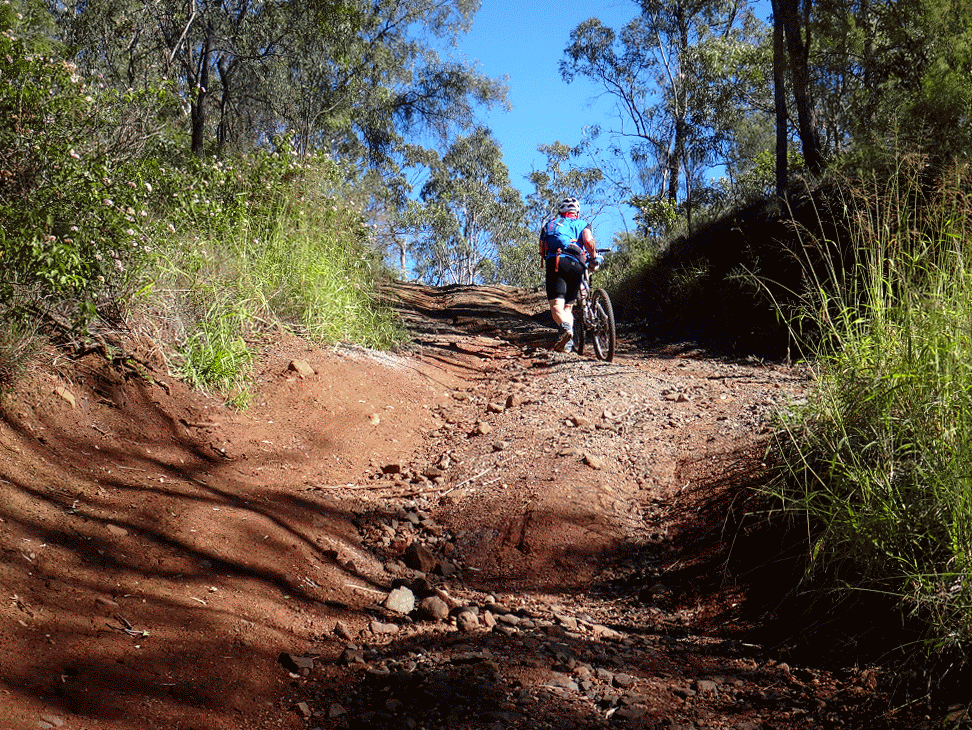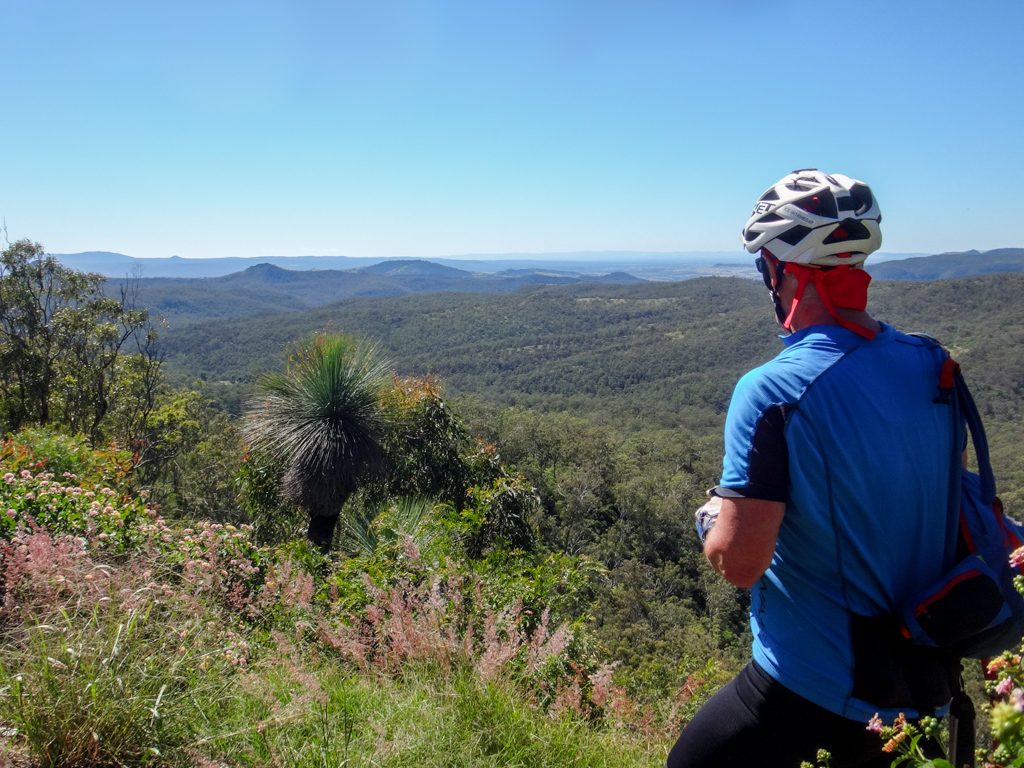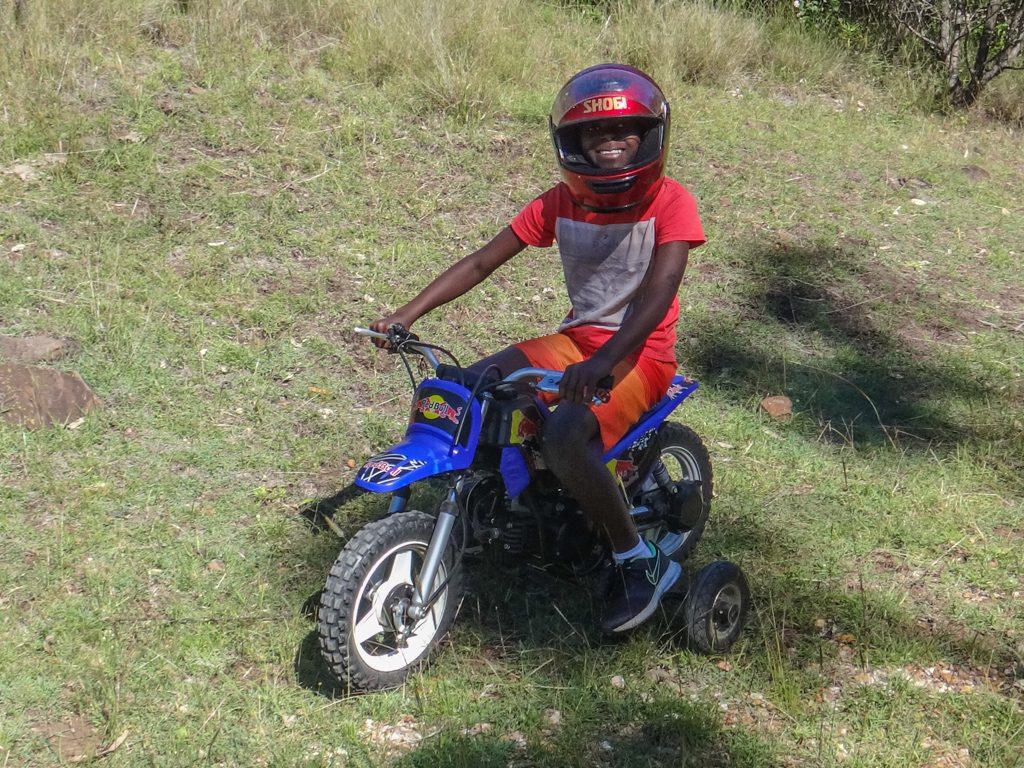Almost 200 years ago, a convict named John Baker escaped the brutal Moreton Bay penal colony to live with the Goomburra Aboriginal People in the Lockyer Valley. He walked long distances with them following winding tracks up and down the Great Dividing Range. Today we followed some of those tracks.
We started in Upper Flagstone at “The Barn” – a cafe at the foot of the range. The owner, Scotty, told me “normal” cyclists also visited his cafe. I took it as a compliment that Scotty didn’t think we were quite “normal”.
Our friend, Steve, owns land nearby. He kindly allowed us to ride through his property, offering to ride with us part of the way too.
We followed gravel roads slowly up into the hills.
There’s a memorial at the foot of Gorman’s Gap Road to Lieutenant Owen Gorman. Gorman was commandant of the Moreton Bay penal colony. When John Baker returned from the Lockyer Valley after escaping fourteen years earlier, he and Gorman spoke about the tracks up the range he had been shown by the indigenous people of the Lockyer Valley.
This was big news. The early European settlers had difficulty getting freight up the range. Almost fifteen years earlier, Alan Cunningham had found a way over the range, but it was steep, treacherous, and over sixty kilometres to the south. If Gorman could find an easier way, it would be a major achievement.
Gorman and Baker loaded up a small cart, hitched it to a bullock, and followed the tracks Baker had seen the Goomburra people use.
The grass is fairly long these days, but the track is still there. We set off up the hill.
As we rode up the gentle slope, I thought to myself “Why did Gorman need a strong bullock to haul his waggon?”
This track didn’t seem too steep to us. Perhaps he could have done with a horse instead?
When the tracks grew steeper, I understood better. This was going to be hard work.
We all grew tired, spinning the pedals to get up some pinch climbs, or just pushing the bikes. Steve has been off the bike for a while and found it very challenging. He decided to roll back down the hill and leave us to continue without him.
Even though parts of the trail were too steep to ride, or overgrown with Lantana, it was easy to follow.
When the track levelled out slightly we started pedalling again.
The final section of the climb was “Archers Slide”. We couldn’t even push the bikes up some parts, having to carry them on our backs.
It might have been an atrocious track for a bullock dray, but the views were very impressive.
We had to battle Lantana in one or two places before finally reaching the top.

The summit had been cleared of trees. We enjoyed an expansive view of the Lockyer Valley.
Eric pointed out the route by which we had come from Flagstone Creek.
We rode south for a while along the edge of the range, enjoying the views to the east.
At Rockmount Road we rolled back down the range.
The road followed Stockyard Creek as it twisted down the valley between rocky hills.
At this point, we could have just followed Stockyard Road back to the start, but we were feeling a little “underdone” and wanted to ride a bit further. At Sawpit Gully Road we followed the Bicentennial National Trail south, back up into the hills.
This climb was a little easier than the last. There was no pushing. We slowly twisted upwards through rocky gullies.
As we ascended, the patchwork landscape unfolded behind us.
This is remote country, miles from anywhere…
… so we were most surprised when this little fellow emerged from the bushes on a miniature motorbike with training wheels.
We followed our new friend for a short way to make sure we were going in the right direction.
A motorbike with training wheels? Who would have thought it!
“We’re going to Dwyers Scrub” I told the man at the caravan.
“It’s over there.” He pointed to the hill behind him and reassured us we were on the right track.
Some bright new BNT trail markers confirmed his advice. We were going in the right direction.
Spinnach Creek Road snaked through fields of long grass.
We paused to enjoy another panorama just before the track started twisting down the range.
I had spoken to a local landowner a few days prior, to arrange permission to cross his land.
Peter had given me precise instructions about where to go.
A farm gate was barely visible in the long grass.
My friends looked at me quizzically. “We’re going down there?”
The farm track zig-zagged down the hill. The chest-high “fukawi” grass obscured rocks and logs. We rolled slowly downward, with one eye on the GPS plot.
Peter’s instructions were perfect. We reached the bottom unscathed.
We tip-toed over the boulders in Spinnach Creek…
…and then began our final climb of the day up to Dwyers Scrub.
After a while the steep hike-a-bike track flattened out, allowing us to start turning the pedals again.
I was surprised when we reached the top. A broad dirt road cut a swathe through the trees.
We followed the dirt track north towards the Egypt Plateau with more rolling hills and picturesque hills on the horizon.
This is a pretty part of the world.
At the edge of the plateau, we coasted down Kennedy’s Road. I’ve ridden up here before and told Pete I enjoyed the downward version much better.
From there it was a leisurely ride on reasonably flat roads back to our starting point.
Total climbing: 1820 m
Average temperature: 23.8
Total time: 05:41:41
More data
We rode about 53 kilometres in about five and a half hours.
During that time we climbed about 1,350 metres in vertical ascent, and I burned just under 3,100 kcal.
This is a challenging ride with several very steep “hike a bike” sections. It would be much more challenging in summer and could get muddy after rain.
I’ll rate it 8.5 out of 10 on the tough-o-meter.
Thanks Eric, Pete, Dean and Steve for a great ride.
Thanks also to landowners Peter and Steve for letting us ride through your beautiful properties.
















































A great read,my great greatgrandfather was Lieut Owen Gorman his son Constable Patrick Owen Gorman was stationed at Gundagai and captured bushranger Captain Moonlite.
Hi Don
Thanks for dropping by.
Congratulations on your famous ancestry.
Have you ever visited Gorman’s Gap?
Neil
No Neil i hope to get there next year with caravan,looks like The Barn at Upper Flagstone is the best place to see his memoral regards Don.
My great great grandfather too. I have his commissions on vellum signed by Lord Melbourne. Handed down through Patrick (g.grandfather) and Mary Gorman ( grandmother).
HI GEOFFREY I TRIED TO SEND YOU A EMAIL BUT NO LUCK glandore@activ8.net.au IS MINE , I LIVE AT 1041 CULLINGRAL RD MERRIWA 2329 AND PH 0265482591 IT WOULD BE GREAT TO MEET YOU REGARDS DON GORMAN.
I GOT TO GO UP LAST DECEMBER AND WALK TO THE CAMELS HUMP THEN WAS UP THERE A COUPLE OF WEEKS AGO HELPING FRIENDS OF GORMANS GAP WITH THERE WORKING BEE.